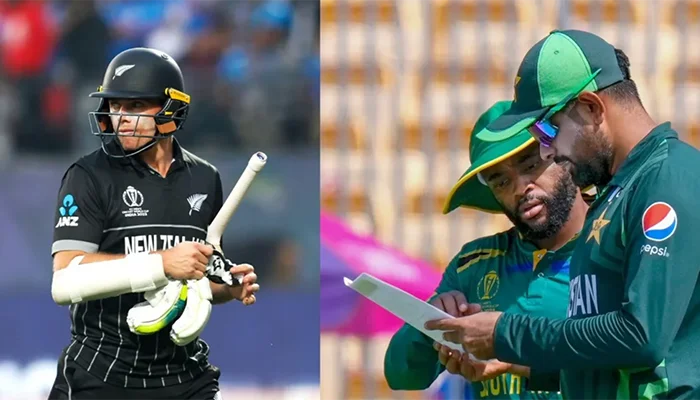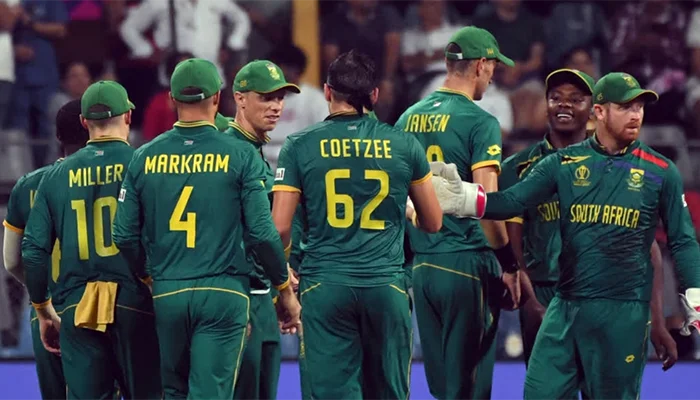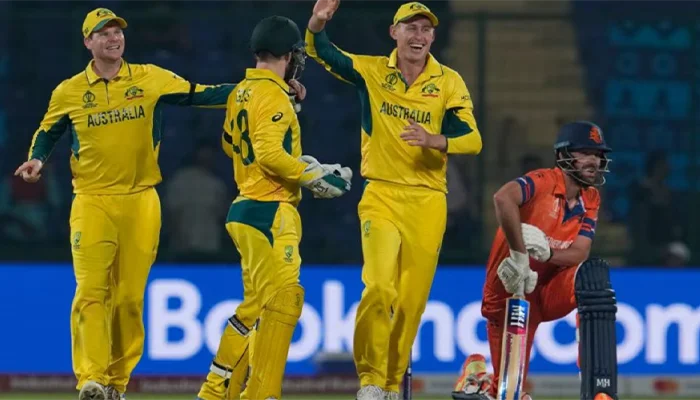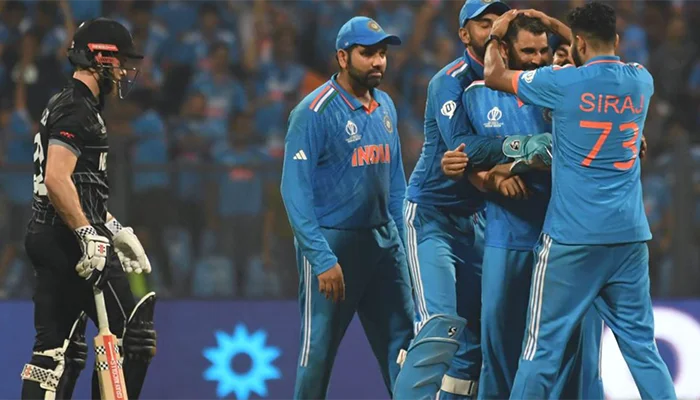Net Run Rate Nonsense: Grab Your Calculators, Folks!

(Net Run Rate played a crucial factor in the 2023 ODI World Cup)
Imagine India and Pakistan playing in the Semi-Finals of an ODI World Cup and during the match, just before the DLS could have been applied, the Rain Gods decide to intervene. Furthermore, with both teams on the same number of points, how will you decide which team is going to make it to the Finals now? This is where the concept of Net Run Rate was introduced to make sure that the team that has dominated throughout the League Stage always gets the benefit of it in the later part of the tournament. And if you are wondering how this whole thing is calculated, then this complete guide is for you where we will be going through the complete process to understand it.
Introduction to Net Run Rate
Cricket has always been a sport that has been home to some interesting and shocking things on the ground. Just like this, the concept of Net Run Rate was introduced in the year 1992 during the ODI World Cup where the points table system along with the coloured jerseys came into life. Net run rate (NRR) is like cricket's speedometer, showing how fast a team scores compared to how fast they're scored against. Imagine it as checking who's running faster in a race but with cricket runs instead of footsteps.

(South African team during the ODI World Cup 2023)
In a single game, NRR tells us the average speed at which one team scores runs per over, minus how fast the other team scores against them. It's like comparing how fast one runner is sprinting to how quickly another runner is catching up. Now, in a tournament, NRR looks at the overall speed of scoring and conceding runs across all the games. It's like averaging out the speeds of all the racers in the marathon. The goal? To have a positive NRR, means you're outpacing your opponents overall. But here's the twist: NRR doesn't care about how big your wins are. It's only interested in speed, not margin.
So, even if a team wins by a huge margin, it doesn't necessarily mean their NRR will be high. Some folks find NRR as puzzling as trying to solve a Rubik's cube blindfolded. And critics say it doesn't always show who's truly the best. Sometimes, a team moves forward in the tournament just because their NRR is better, not because they played better. So, while NRR adds a bit of mathematical flair to cricket, it's not always the perfect scorecard. It's like trying to measure a race with a stopwatch that doesn't count the hurdles.
How to Calculate the Net Run Rate
In cricket, Net Run Rate (NRR) is like the scoreboard's secret sauce—it tells us how well a team is scoring compared to their opponents. But how does this magical number come about? Imagine you're baking a cake, and you want to know how sweet it is compared to others. NRR is like tasting each cake and figuring out which one is the sweetest. To find a team's NRR in a match, we look at how many runs they scored per over, and then we subtract how many runs their opponents scored per over. It's like comparing the sugar content in each slice.

(Australian team during the 2023 ODI World Cup against the Netherlands)
Now, let's say you're planning a road trip, and you want to know who's driving faster. NRR is like calculating the average speed of each car and seeing who's zooming ahead. If one car is cruising at a higher speed than the others, its NRR will be positive, showing it's leading the pack. But if it's lagging behind or getting overtaken too often, its NRR might dip into the negative zone. In simpler terms, NRR is like comparing apples to oranges, but in cricket runs per over.
It helps teams see if they're scoring fast enough and if they're defending well against their opponents' attacks. It's not just about how many runs they make, but how efficiently they make them and how they stack up against others. So, the next time you're watching a cricket match, remember that NRR is the secret ingredient in the recipe for success. It's the sweet taste of victory and the bitter pill of defeat, all rolled into one delicious number.
Let’s Understand by an Example
Let's dive into a cricket match between India and New Zealand. India bats first and scores 260 runs for the loss of 2 wickets in 50 overs. New Zealand then tries to chase it down but manages to score only 200 runs for the loss of 5 wickets in their 50 overs. Now, let's talk numbers. To figure out India's Net Run Rate (NRR) for this match, we look at how fast they scored compared to New Zealand. India's run rate is calculated by dividing their total runs by the number of overs they played. So, it's 260 runs divided by 50 overs, giving us an average of 5.20 runs per over.

(India vs New Zealand Semi-Finals in the 2023 ODI World Cup)
For New Zealand, it's 200 runs divided by 50 overs, which equals 4.00 runs per over. To find India's NRR, we subtract New Zealand's run rate from India's. So, it's 5.20 (India's run rate) minus 4.00 (New Zealand's run rate), which equals +1.20. This positive value shows that India scored faster on average than New Zealand during the match. In cricket, having a higher NRR is like having a higher score—it's always better. It means you're scoring more runs per over compared to your opponent.
Now, let's zoom out and look at the bigger picture. To calculate a team's NRR throughout the competition, we follow a similar process. We add up all the runs they scored in all their matches and divide that by the total number of overs they faced. Then, we subtract the runs their opponents scored against them from the total number of overs their opponents faced. This helps teams understand how they performed overall in the competition, considering both their ability to score runs and their ability to stop their opponents from scoring too many.
2019 IPL Points Table
One of the most visible cases of the Net Run Rate came into existence during the 2019 season of the Indian Premier League when the tournament was held between 8 teams and only 4 teams had the opportunity to play in the Playoffs. Here we can see Mumbai Indians, Chennai Super Kings and Delhi Capitals qualifying for the playoffs with a total of 18 points each and considering the Net Run Rate, Mumbai Indians is at the top of the table because of their better impact in the League Stage games played by them.
|
TEAM |
Played |
Won |
Lost |
Tied |
No-Result |
Points |
Net Run Rate |
|
Mumbai Indians (MI) (Q) |
14 |
9 |
5 |
0 |
0 |
18 |
+0.421 |
|
Chennai Super Kings (CSK) (Q) |
14 |
9 |
5 |
0 |
0 |
18 |
+0.131 |
|
Delhi Capitals (DC) (Q) |
14 |
9 |
5 |
0 |
0 |
18 |
+0.044 |
|
Sunrisers Hyderabad (SRH) (Q) |
14 |
6 |
8 |
0 |
0 |
12 |
+0.577 |
|
Kolkata Knight Riders (KKR) |
14 |
6 |
8 |
o |
0 |
12 |
+0.173 |
|
Kings XI Punjab (KXIP) |
14 |
6 |
8 |
0 |
0 |
12 |
-0.251 |
|
Rajasthan Royals (RR) |
14 |
5 |
8 |
0 |
1 |
11 |
-0.449 |
|
Royal Challengers Bangalore (RCB) |
14 |
5 |
8 |
0 |
1 |
11 |
-0.607 |
(2019 IPL Points Table)
Now coming to a bigger picture here, for the fourth place in the League, a total of 3 teams were fighting and all of them ended up with 12 points each which shows the competitiveness of the Indian Premier League and the teams being determined to win here. Sunrisers Hyderabad, Kolkata Knight Riders, and Punjab Kings had the chance to take the fourth spot, and with all of them playing the same number of matches and with the same number of wins, it was Sunrisers Hyderabad who got into the Playoffs because of the better Net Run Rate which was due to their overall better impact in the League Stage.
Criticism of Net Run Rate
With the introduction of Net Run Rate in Cricket, things have been spiced up amongst the teams because of them making sure that they dominate at each and every part of the League to lift the championship. However, with the arrival of this, it has also had a negative impact on the game and one of example was visible in the 2019 ODI World CUP where Pakistan failed to qualify for the Semi-Finals as they were hit by rain in one of their league stage games. With New Zealand and the Pakistan team having the same number of points, it was the New Zealand team that managed to get into the Semi-Finals.
|
# |
TEAM |
Matches |
Won |
Lost |
No-Result |
Tie |
Points |
Net Run Rate |
|
1 |
INDIA |
9 |
7 |
1 |
1 |
0 |
15 |
0.8087 |
|
2 |
AUSTRALIA |
9 |
7 |
2 |
0 |
0 |
14 |
0.8676 |
|
3 |
ENGLAND |
9 |
6 |
3 |
0 |
0 |
12 |
1.1523 |
|
4 |
NEW ZEALAND |
9 |
5 |
3 |
1 |
0 |
11 |
0.1661 |
|
5 |
PAKISTAN |
9 |
5 |
3 |
1 |
0 |
11 |
-0.4302 |
|
6 |
SRI LANKA |
9 |
3 |
4 |
2 |
0 |
8 |
-0.9188 |
|
7 |
BANGLADESH |
9 |
3 |
5 |
1 |
0 |
7 |
-0.4105 |
|
8 |
SOUTH AFRICA |
9 |
3 |
5 |
0 |
1 |
7 |
-0.4511 |
|
9 |
WEST INDIES |
9 |
2 |
6 |
0 |
1 |
5 |
-0.2841 |
|
10 |
AFGHANISTAN |
9 |
0 |
9 |
0 |
0 |
0 |
-0.9038 |
(2019 ODI World Cup Points Table)
With things not going in Pakistan’s favour and after they were knocked out from the tournament, Pakistan’s coach Mickey Arthur came out and said that the Net Run Rate system is an absolute crap and the ICC should look into the matter.
“I would have liked the ICC to consider head to head because tonight we would be in the semi-final. It is disappointing, and it just goes back to our first game [a heavy defeat] against the West Indies. And we had an opportunity to beat Australia, and we didn't take that. Those are the two nightmares I'm going to have. What the system has done to us is that after one very poor game, you really battle to recover again.”
“So it's a very disappointed dressing room, no congratulations going on because we haven't qualified. Congratulations to the four who have, I think they've played the best cricket so far and may the best team win. But it is nice for us to sit here and know we've beaten two of those teams [England and New Zealand] which shows we're not a mile off in terms of ourselves as a cricket team.”

Comments
Sign up or log in to your account to leave comments and reactions
0 Comments